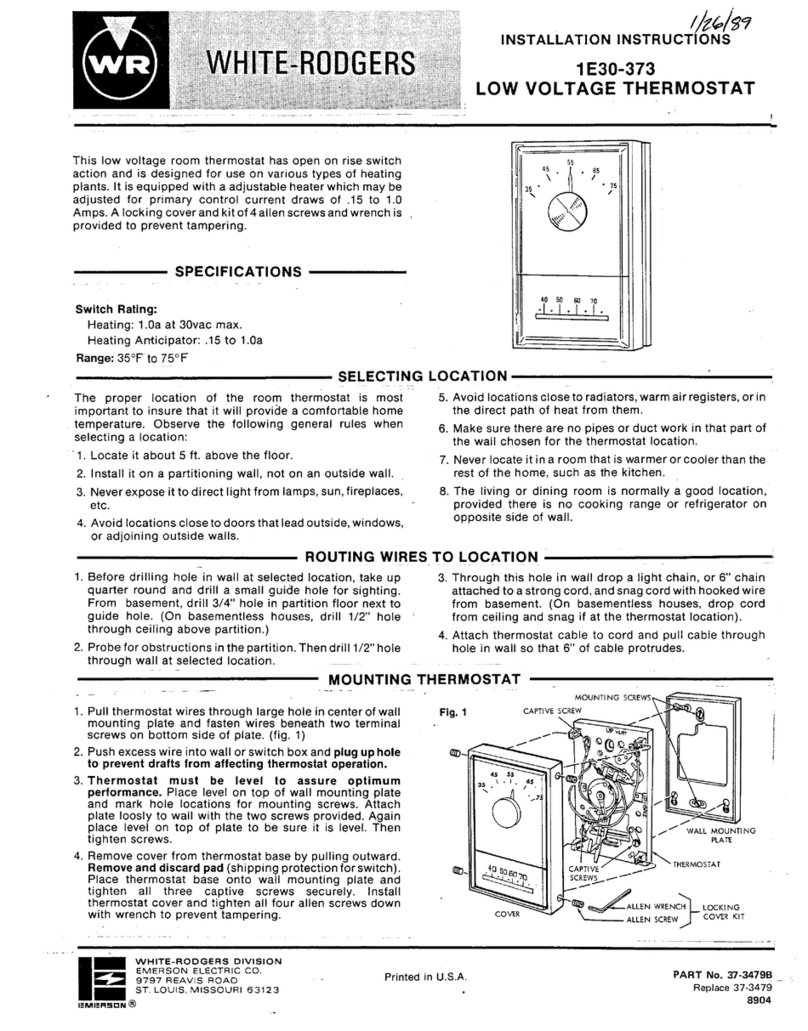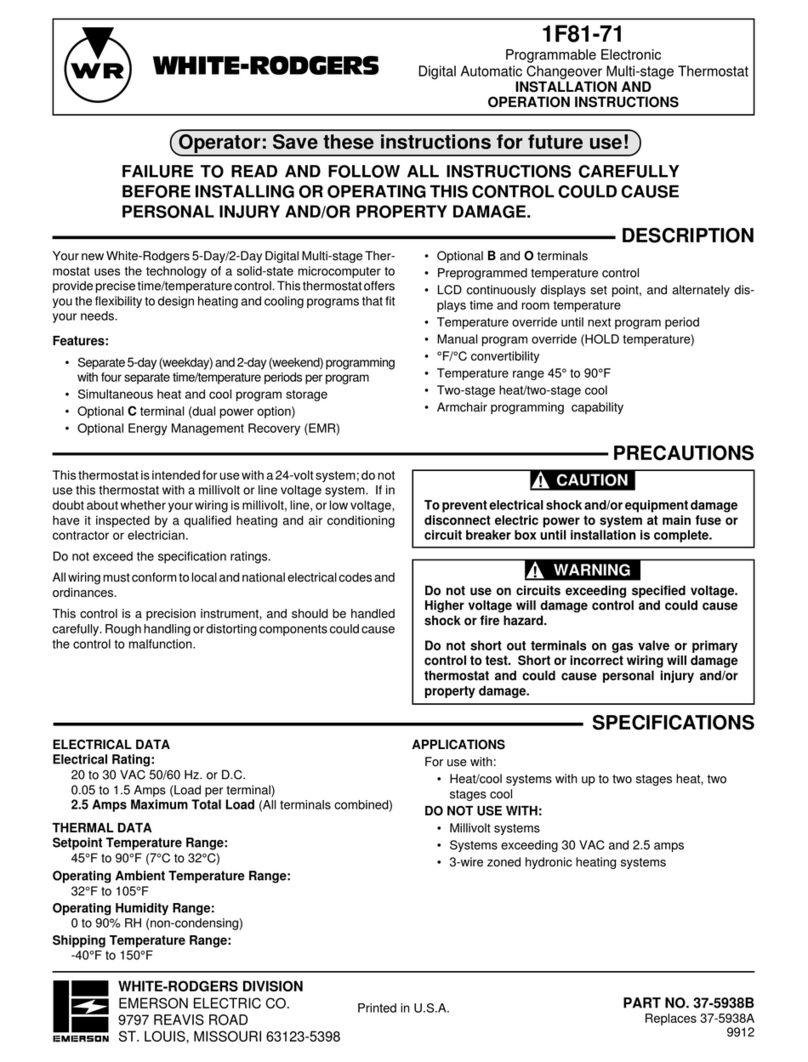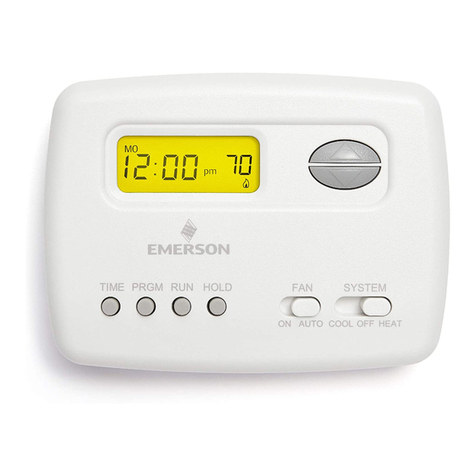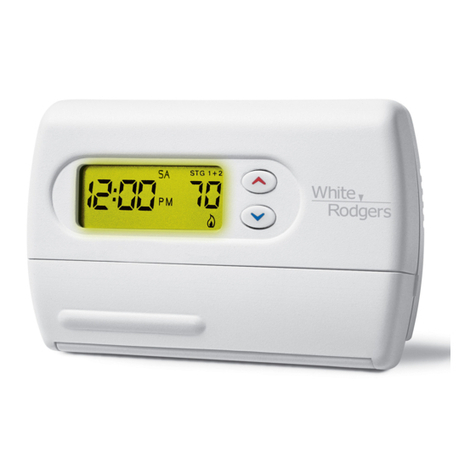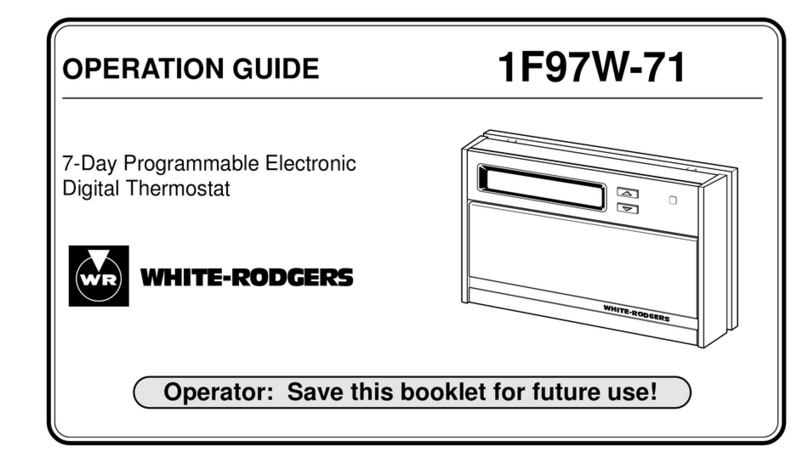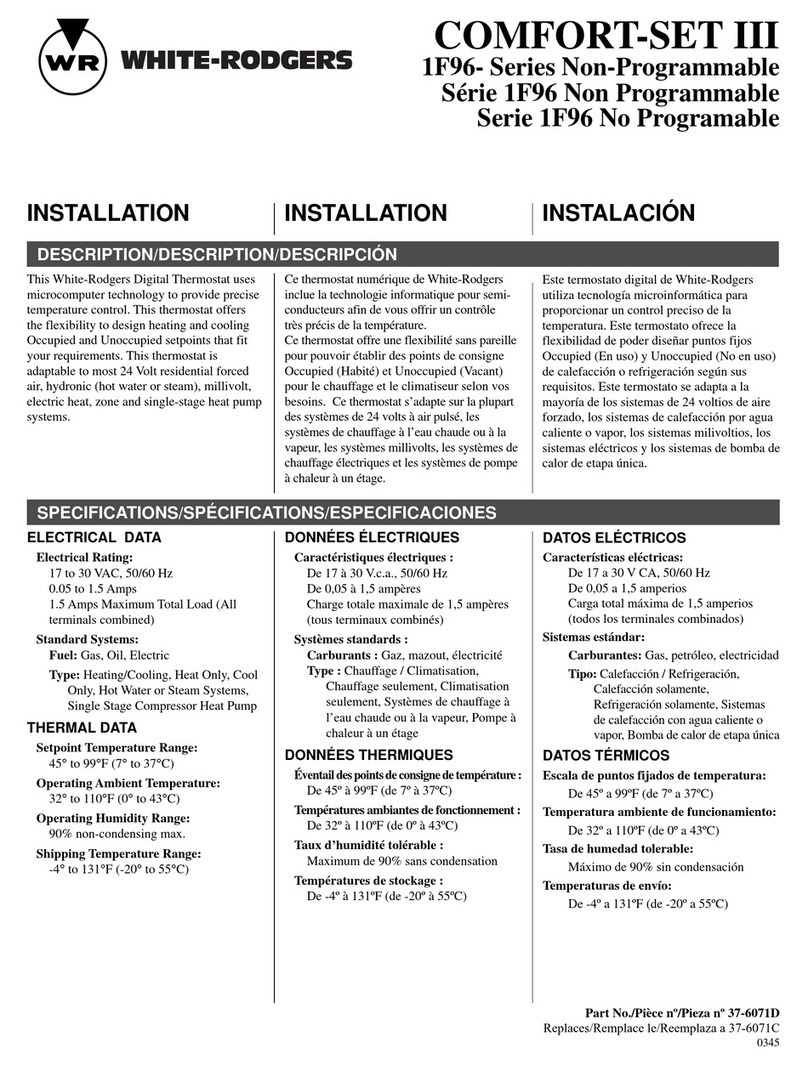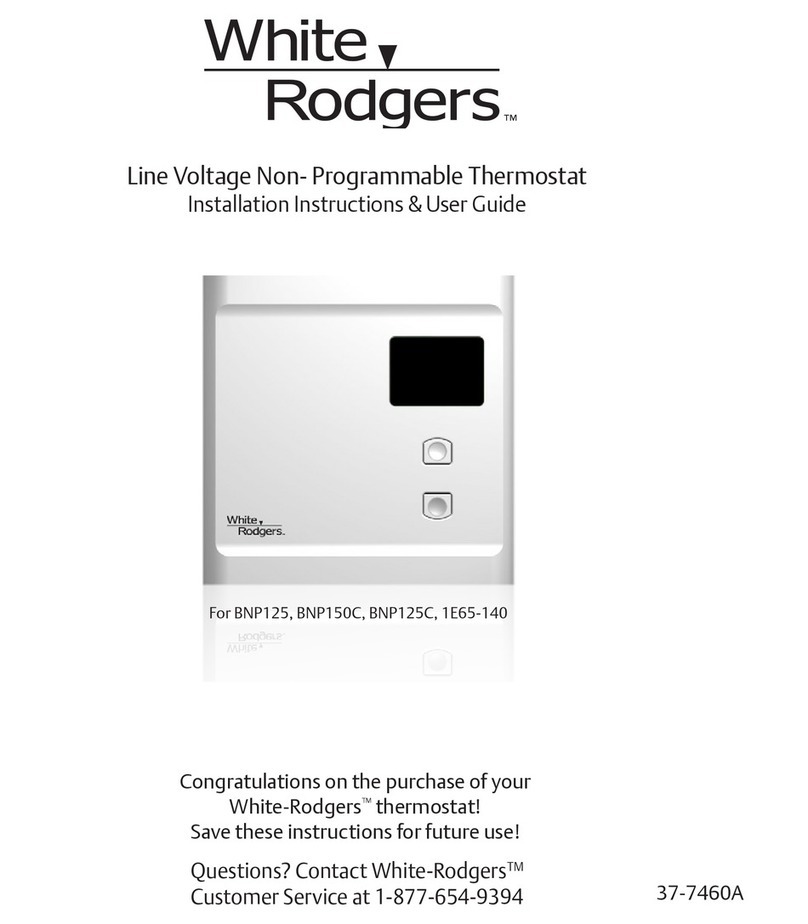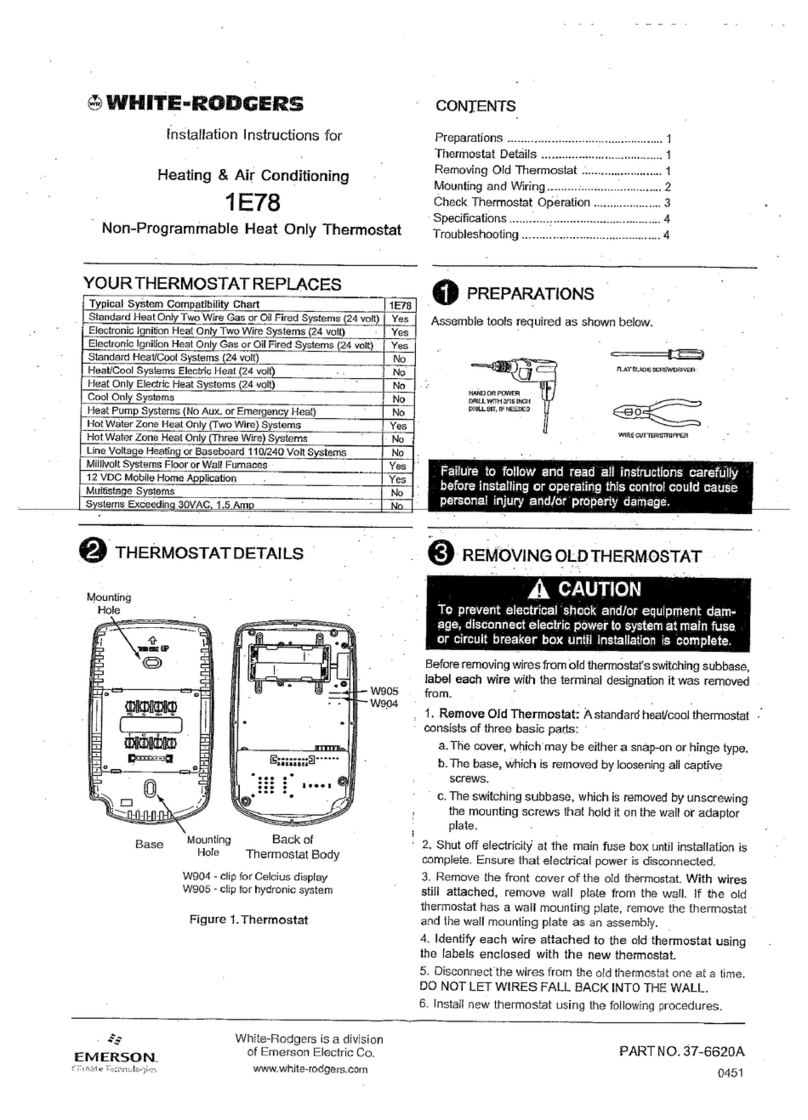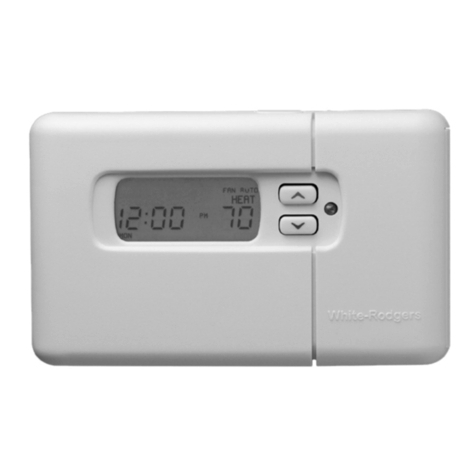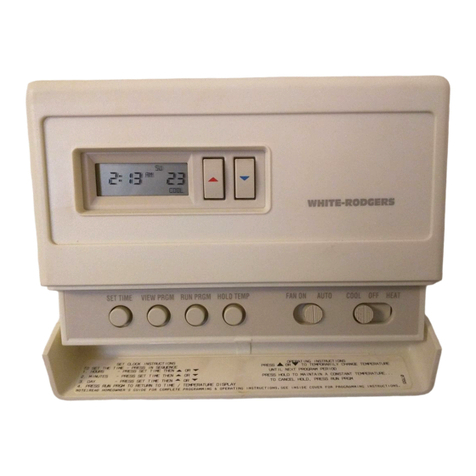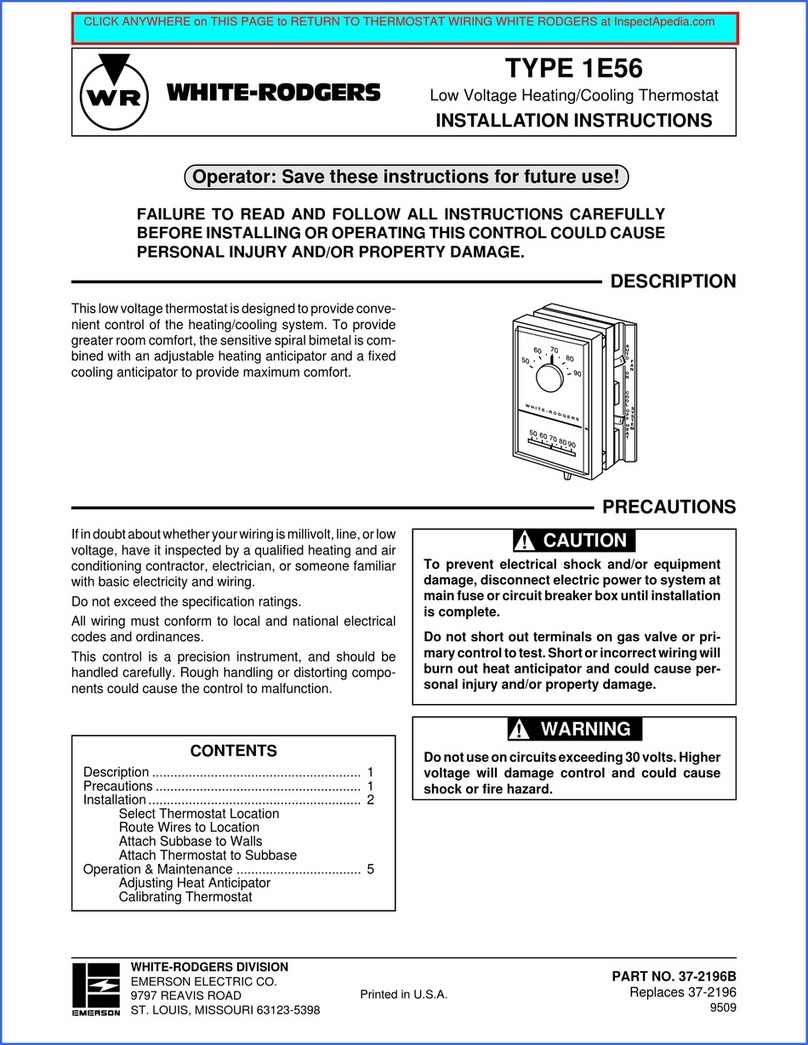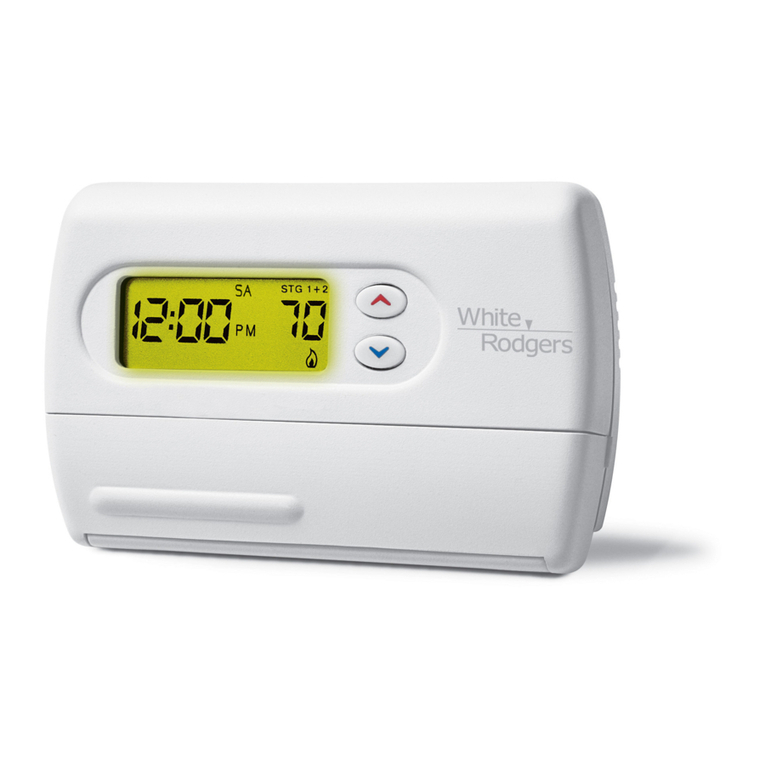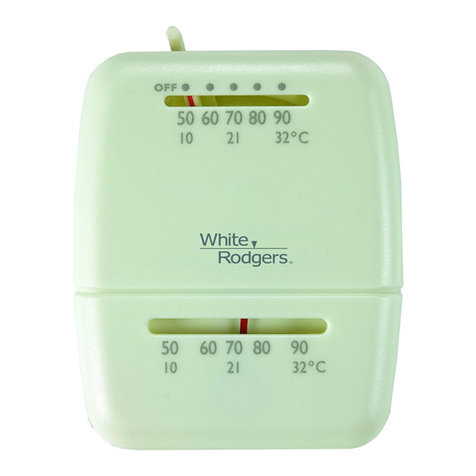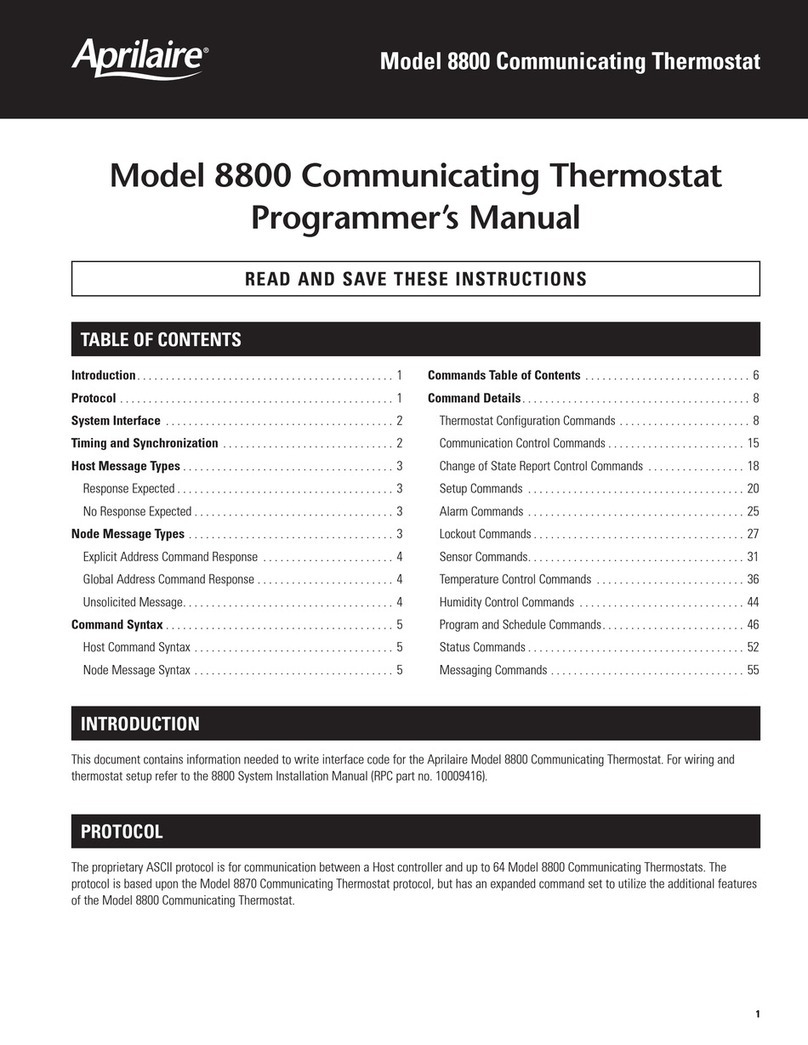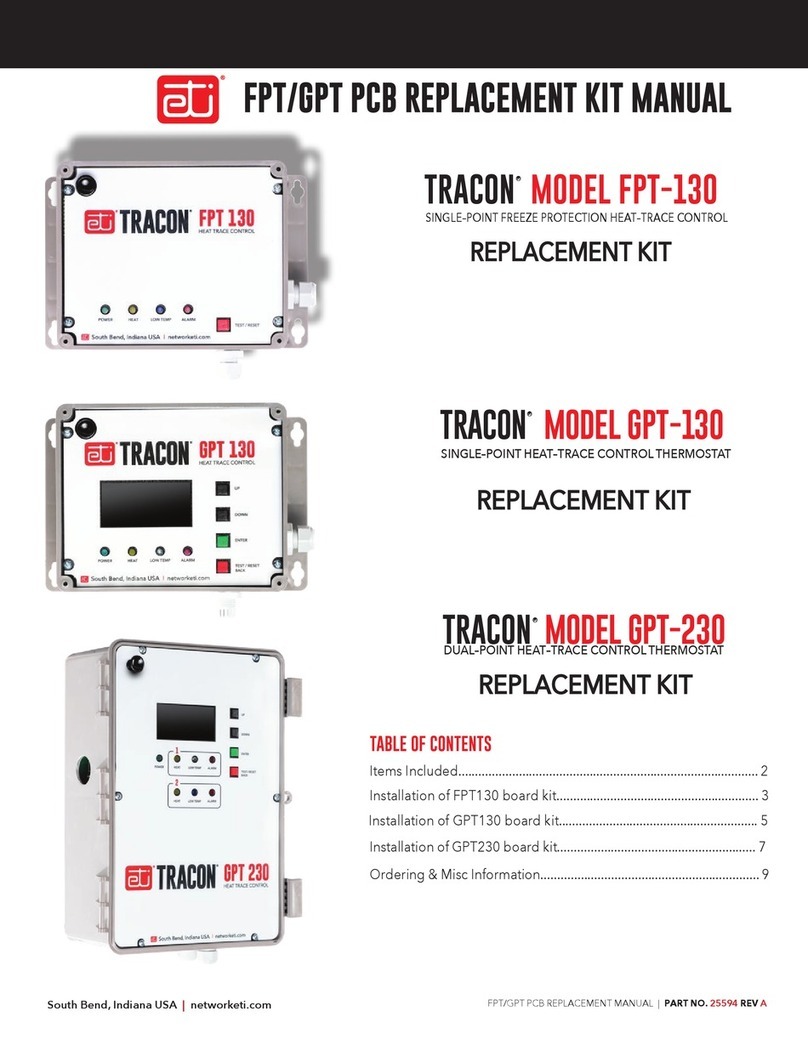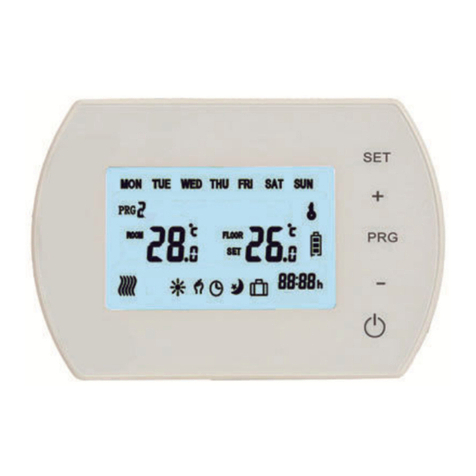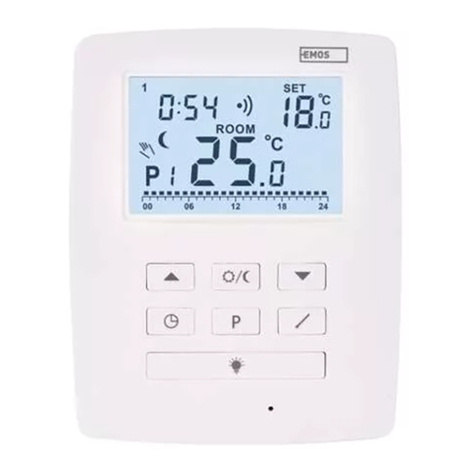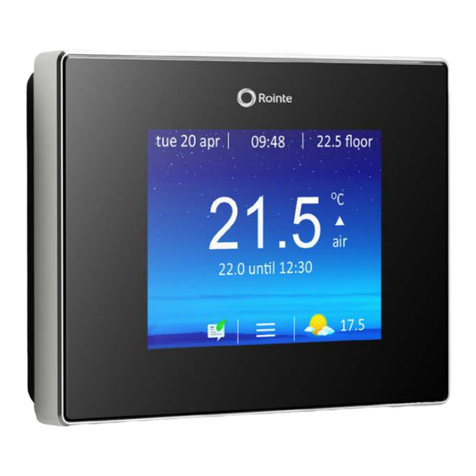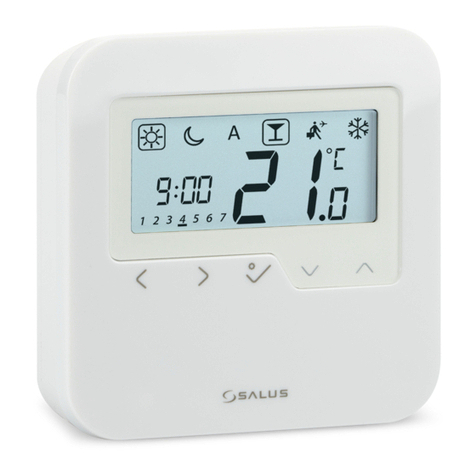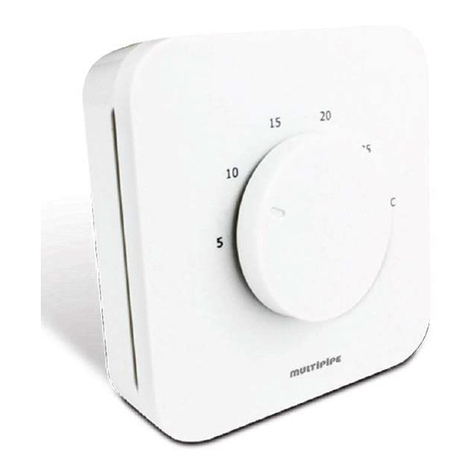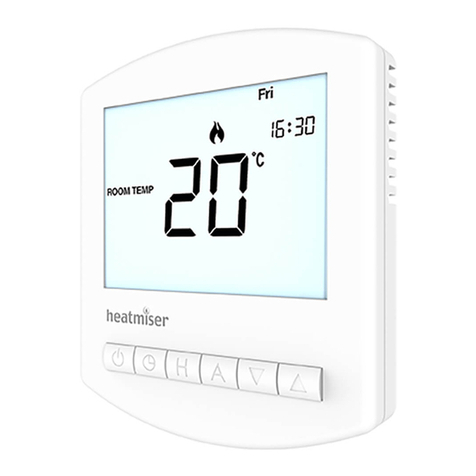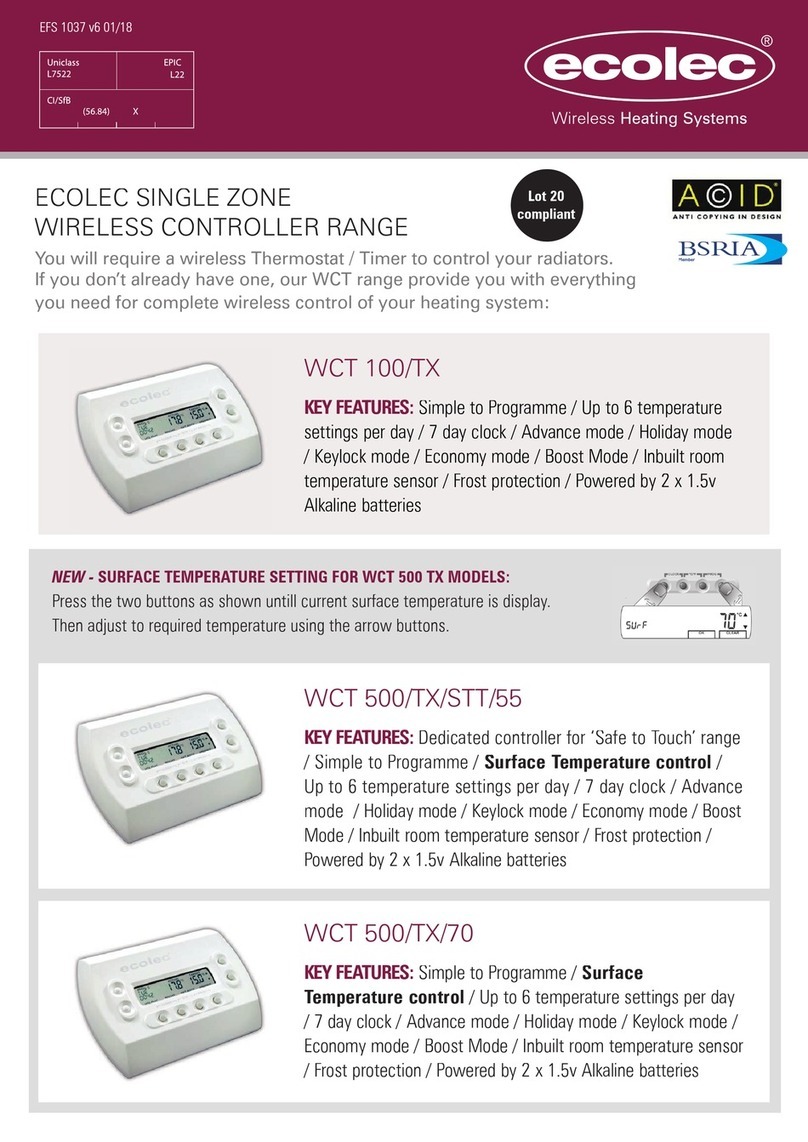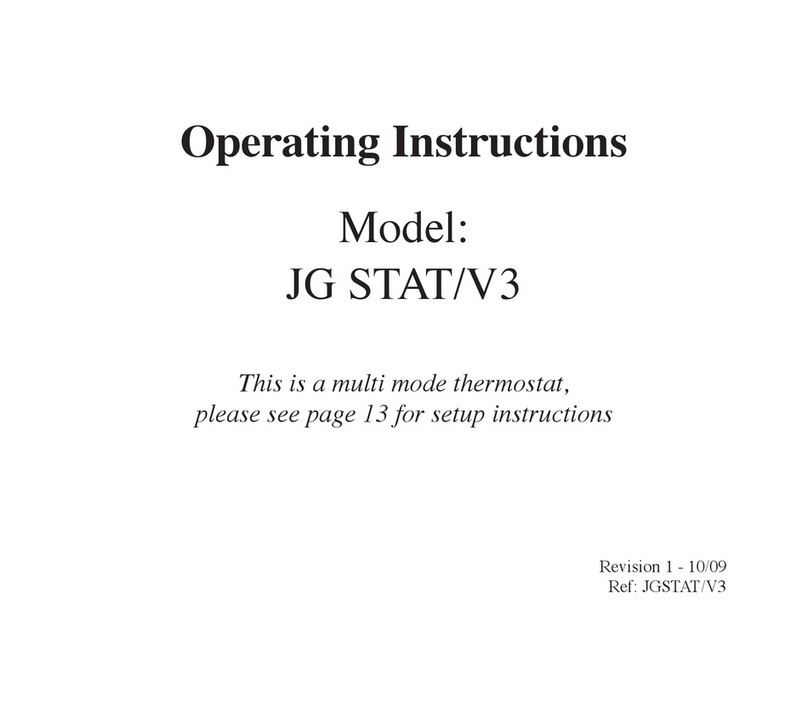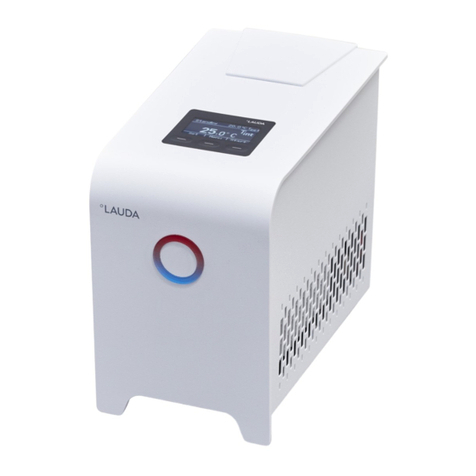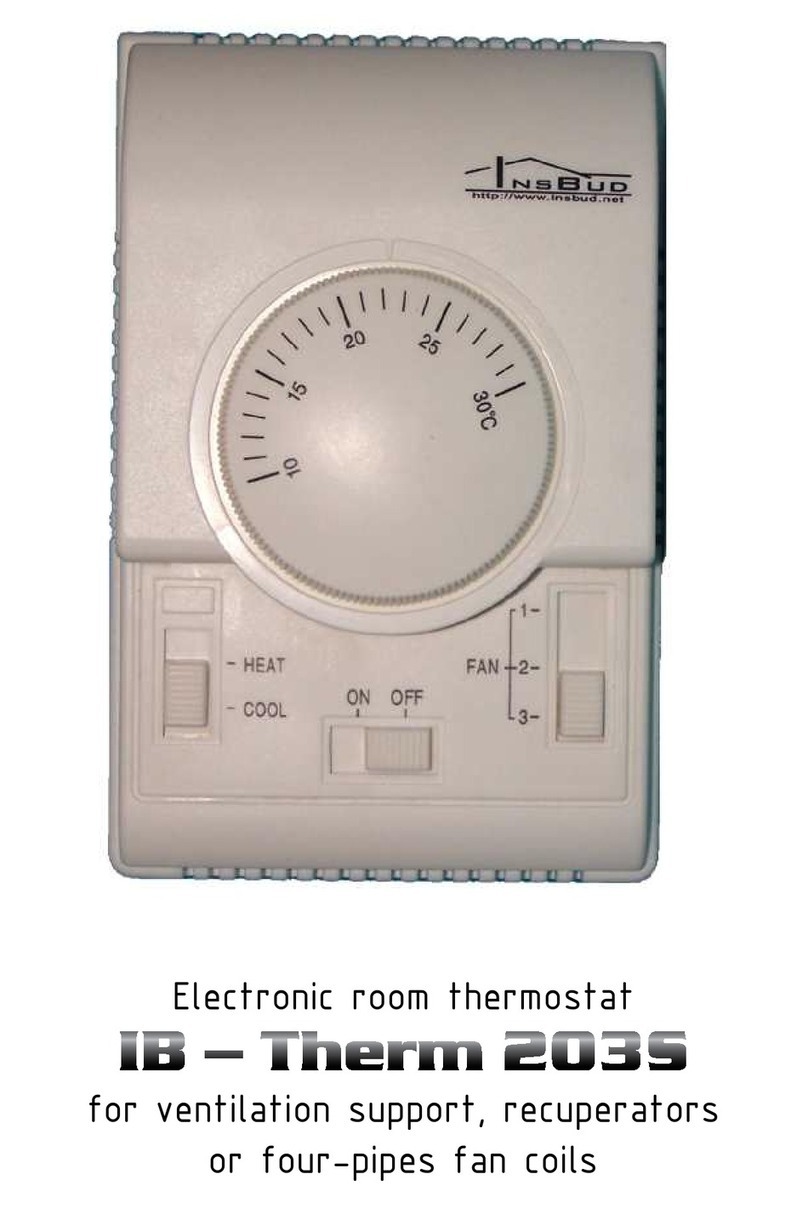
7
4° higher or lower. Your thermostat was accurately
calibrated at the factory but you have the option to
change the display temperature to match your previous
thermostat. The current or adjusted room temperature will
be displayed on the left side of the display.
15)Select Temporary Program Override TimeSelect Temporary Program Override Time
Select Temporary Program Override TimeSelect Temporary Program Override Time
Select Temporary Program Override Time–The thermo-
stat can hold any temperature you set it to for the amount
of time you select on this option. Your choices are 0:00 to
8:00 hours in 15 minute increments. 0:00 means disable.
Example:
1. You have selected 3:00 hours for the Temporary Pro-
gram Override time period.
2. With the thermostat set to Heat or Cool, press HOLD
for approximately 5 secondsfor approximately 5 seconds
for approximately 5 secondsfor approximately 5 seconds
for approximately 5 seconds until "HOLD time 3:00HOLD time 3:00
HOLD time 3:00HOLD time 3:00
HOLD time 3:00"
(indicating 3 hours) appears as a setting reminder.
3. After releasing the button, "HOLDHOLD
HOLDHOLD
HOLD"
on the display will
blink.
4. Use or to set the temperature to your prefer
ence. The thermostat will maintain this temperature
setting for 3 hours with "HOLDHOLD
HOLDHOLD
HOLD"
blinking to remind you
it is in Temporary Hold. After 3 hours, the thermostat
will go back to the program temperature and "HOLDHOLD
HOLDHOLD
HOLD"
will no longer blink or display.
16)Select F° or C° ReadoutSelect F° or C° Readout
Select F° or C° ReadoutSelect F° or C° Readout
Select F° or C° Readout – Changes the display readout
to Celsius or Fahrenheit as required.
17)Limited Heat RangeLimited Heat Range
Limited Heat RangeLimited Heat Range
Limited Heat Range – This feature provides a maximum
setpoint temperature for heat. The default setting is 90°F. It
can be changed between 62°F and 89°F by pressing the
or key.
18)Limited Cool RangeLimited Cool Range
Limited Cool RangeLimited Cool Range
Limited Cool Range – This feature provides a minimum
setpoint temperature for cool. The default setting is 45°F. It
can be changed between 46°F and 82°F by pressing the
or key.
19)Comfort AlertComfort Alert
Comfort AlertComfort Alert
Comfort Alert – This feature is available in Passive
mode on this thermostat. If a Comfort Alert module is
connected, the thermostat will receive and flash the fault
codes from the Comfort Alert module.
20 & 21) Keypad LockoutKeypad Lockout
Keypad LockoutKeypad Lockout
Keypad Lockout – This menu selection will
display locklock
locklock
lock ( ) icon. The and are used to toggle
the function and display the locklock
locklock
lock icon and OFFOFF
OFFOFF
OFF (keypad
not locked out, default) indicating in the time digits to the
locklock
locklock
lock icon and ONON
ONON
ON (keypad locked out). When the keypad
lockout function is enabled (ONON
ONON
ON), and the SYSTEM button
is pressed again, the display will indicate the number 000000
000000
000
(default, still disabled) in the time digits. The and
are used to set the combination number from 00
00
0 to 999999
999999
999. If
a combination of 000000
000000
000 is selected and the SYSTEM button
is pressed, the menu will be exited and keypad will not be
locked. If 1 to 9991 to 999
1 to 9991 to 999
1 to 999 is selected and the SYSTEM button is
pressed again, the combination is locked into non-volatile
memory and the menu is exited. The locklock
locklock
lock icon (to
designate keypad locked with a valid combination) will
display when the menu is exited. The SYSTEM button will
operate for 10 seconds after the menu mode is exited to
allow the user to change the mode from OFFOFF
OFFOFF
OFF to the
desired system mode.
While the keypad is locked out, a simultaneous press of
and will enter the menu item from any mode
instead of only OFFOFF
OFFOFF
OFF mode. When the menu is entered
with the keypad lockout feature enabled, the first menu
item displayed is the combination code 00
00
0. The or
keys are used to set the combination unlock number from
00
00
0 to 999999
999999
999. If the unlock number matches exactly with the
combination lock number stored in memory when the
SYSTEM button is pressed, the keypad is unlocked and
the locklock
locklock
lock icon is removed. If the unlock number does not
match when the SYSTEM
button is pressed, menu is
exited and the keypad remains disabled.
To reset the combination code and unlock the keypad if
the code is forgotten, see troubleshooting section, page
16.
setting on the remote. This is only used in areas where
there are other wireless devices or electronic equipment
that interfere with the default frequency of the thermostat/
remote sensor communication.
7) Programmable PeriodsProgrammable Periods
Programmable PeriodsProgrammable Periods
Programmable Periods – This control can be config-
ured for 4, 2 or 0 programmable periods. The display
indicates "PRG 4PRG 4
PRG 4PRG 4
PRG 4" in the display as default. The program-
mable periods can be changed to 2 or 0 by pressing the
or keys. With "PRG 0PRG 0
PRG 0PRG 0
PRG 0" selected for non-program-
mable, SYSTEM key selection will skip EMREMR
EMREMR
EMR (item 8) and
temporary program override (item 15).
8) Select Energy Management Recovery OFF or ONSelect Energy Management Recovery OFF or ON
Select Energy Management Recovery OFF or ONSelect Energy Management Recovery OFF or ON
Select Energy Management Recovery OFF or ON –
Energy Management Recovery (EMR) causes the
thermostat to start heating or cooling early to make the
building temperature reach the program setpoint at the
time you specify. Heating will start 5 minutes early for
every 1° of temperature required to reach setpoint.
Example:Example:
Example:Example:
Example: You select EMR and have your heating
programmed to 65° at night and 70° at 7 AM. If the
building temperature is 65° the difference between 65°
and 70° is 5°. Allowing 5 minutes per degree the thermo-
stat setpoint will change to 70° at 6:35 AM. Cooling allows
more time per degree because it takes longer to reach
temperature.
9) Fast or Slow Cycle SelectionFast or Slow Cycle Selection
Fast or Slow Cycle SelectionFast or Slow Cycle Selection
Fast or Slow Cycle Selection – The factory default
setting is fast cycle, which cycles 1st stage at approxi-
mately 1.2°F and 2nd stage 0.75°F. If you prefer slow
cycle, press the temperature key to change to SL. The 1st
stage and 2nd stage would be 1.5°F and 1.2°F respec-
tively.
10)Select Compressor Lockout CL OFF or ONSelect Compressor Lockout CL OFF or ON
Select Compressor Lockout CL OFF or ONSelect Compressor Lockout CL OFF or ON
Select Compressor Lockout CL OFF or ON – Selecting
CL ON will cause the thermostat to wait 5 minutes before
turning on the compressor if the heating and cooling
system loses power. It will also wait 5 minutes minimum
between cooling and heating cycles. This is intended to
help protect the compressor from short cycling. Some
newer compressors already have a time delay built in and
do not require this feature. Your compressor manufac-
turer can tell you if the lockout feature is already present
in their system. When the thermostat compressor time
delay occurs it will flash the setpoint for about five
minutes.
11)Select Backlight DisplaySelect Backlight Display
Select Backlight DisplaySelect Backlight Display
Select Backlight Display – The display backlight
improves display contrast in low lighting conditions. When
the "C" terminal is powered, selecting backlight CdL ON
will keep the light on continuously. Select backlight OFF
will keep the light on momentarily after any key is
pressed. When the "C" terminal is not powered, the light
will be on momentarily after any key is pressed no matter
the backlight is selected ON or OFF.
12)Select Fast Second Stage On or OFFSelect Fast Second Stage On or OFF
Select Fast Second Stage On or OFFSelect Fast Second Stage On or OFF
Select Fast Second Stage On or OFF – For HeatFor Heat
For HeatFor Heat
For Heat:
During normal operation if the setpoint temperature is
manually raised by 3°F or more above the actual tem-
perature with the
button, and the fast second stage
feature is enabled, FA ON, the second stage will energize
immediately.
For Cool: During normal operation if the setpoint tempera-
ture is manually lowered by 3°F or more below the actual
temperature with the button, and the fast second stage
feature is enabled, FA ON, the second stage will energize
immediately.
13)Select filter replacement run timeSelect filter replacement run time
Select filter replacement run timeSelect filter replacement run time
Select filter replacement run time – The thermostat will
display "FLTRFLTR
FLTRFLTR
FLTR"
after a set time of operation. This is a
reminder to change or clean your air filter. This time can
be set from 0 to 1950 hours in 50 hour increments. AA
AA
A
selection of 0 will cancel this featureselection of 0 will cancel this feature
selection of 0 will cancel this featureselection of 0 will cancel this feature
selection of 0 will cancel this feature. When "FLTRFLTR
FLTRFLTR
FLTR"
is
displayed, you can clear it by pressing HOLD and RUN at
the same time. This resets the timer and starts counting
the hours until the next filter change. Contact your system
manufacturer for a specific replacement/maintenance
interval.
14)Select Temperature Display Adjustment 4 LO to 4 HISelect Temperature Display Adjustment 4 LO to 4 HI
Select Temperature Display Adjustment 4 LO to 4 HISelect Temperature Display Adjustment 4 LO to 4 HI
Select Temperature Display Adjustment 4 LO to 4 HI –
Allows you to adjust the room temperature display up to
THERMOSTTHERMOST
THERMOSTTHERMOST
THERMOSTAA
AA
AT CONFIGURAT CONFIGURA
T CONFIGURAT CONFIGURA
T CONFIGURATION MENUTION MENU
TION MENUTION MENU
TION MENU
















